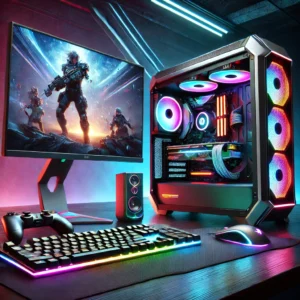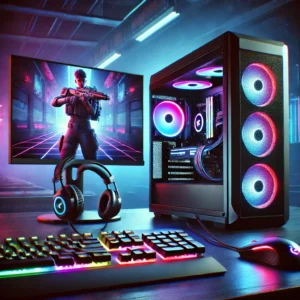Building a gaming PC doesn’t have to break the bank. With careful planning and smart choices, you can create a powerful gaming rig that delivers excellent performance without costing a fortune. This guide will walk you through the process of building a budget-friendly gaming PC, from selecting components to assembling them.

1. Set a Budget
Before diving into parts, decide how much you’re willing to spend. A 500−800 budget is ideal for a decent entry-level gaming PC. If you can stretch to $1,000, you’ll get better performance and future-proofing.
2. Choose the Right Components
Here’s a breakdown of the essential components and budget-friendly recommendations:
a. Processor (CPU)
The CPU is the brain of your PC. For gaming, focus on a balance between cores, clock speed, and price.
- Recommended: AMD Ryzen 5 5600G or Intel Core i3-12100F.
- Why: Both offer excellent performance for their price and can handle modern games.
b. Graphics Card (GPU)
The GPU is critical for gaming performance. On a budget, prioritize value over raw power.
- Recommended: NVIDIA GTX 1660 Super or AMD Radeon RX 6600.
- Why: These cards deliver 1080p gaming at high settings without costing a fortune.
c. Motherboard
Choose a motherboard compatible with your CPU and future upgrades.
- Recommended: B550 (for AMD) or B660 (for Intel).
- Why: These chipsets offer good features like PCIe 4.0 and support for faster RAM.
d. Memory (RAM)
16GB of RAM is the sweet spot for gaming.
- Recommended: Corsair Vengeance LPX 16GB (2 x 8GB) DDR4-3200.
- Why: Fast, reliable, and affordable.
e. Storage
Opt for a combination of SSD and HDD for speed and storage capacity.
- Recommended:
- SSD: Kingston A2000 500GB NVMe (for OS and games).
- HDD: Seagate Barracuda 1TB (for additional storage).
f. Power Supply (PSU)
Don’t skimp on the PSU—it powers your entire system.
- Recommended: EVGA 600 W1, 80+ WHITE, 600W.
- Why: Reliable and sufficient for most mid-range builds.
g. Case
Choose a case with good airflow and cable management.
- Recommended: NZXT H510 or Cooler Master MasterBox Q300L.
- Why: Affordable, stylish, and functional.
3. Assemble Your PC
Once you have all the components, follow these steps to assemble your PC:
Step 1: Prepare Your Workspace
- Use a clean, static-free surface.
- Gather a screwdriver, zip ties, and your components.
Step 2: Install the CPU
- Open the CPU socket on the motherboard.
- Align the CPU with the socket and gently place it in.
- Secure it with the retention arm.
Step 3: Install the RAM
- Push the RAM sticks into the DIMM slots until they click.
- Ensure they’re properly seated.
Step 4: Mount the Motherboard
- Secure the motherboard to the case using standoffs and screws.
- Connect the case’s front panel connectors (power button, USB ports, etc.).
Step 5: Install the GPU
- Insert the GPU into the PCIe x16 slot.
- Secure it with screws to the case.
Step 6: Install Storage
- Mount the SSD and HDD in their respective bays.
- Connect them to the motherboard using SATA cables.
Step 7: Connect the PSU
- Attach the PSU to the case and connect all necessary cables (24-pin ATX, 8-pin CPU, PCIe for GPU, SATA for storage).
Step 8: Cable Management
- Use zip ties to organize cables for better airflow and aesthetics.
Step 9: Power On
- Double-check all connections.
- Power on the PC and install your operating system (Windows, Linux, etc.).
4. Optimize for Gaming
After assembly, optimize your PC for gaming:
- Update Drivers: Download the latest GPU and motherboard drivers.
- Enable XMP: In BIOS, enable XMP to run your RAM at its rated speed.
- Adjust Settings: Use software like NVIDIA Control Panel or AMD Radeon Software to fine-tune performance.
5. Save Money Without Sacrificing Performance
- Buy Used: Consider used GPUs or CPUs from reputable sellers.
- Bundle Deals: Look for CPU + motherboard combos to save money.
- Future Upgrades: Start with a solid foundation and upgrade components (like GPU) later.
6. Sample Budget Build ($700)
Here’s an example of a budget-friendly gaming PC:
- CPU: AMD Ryzen 5 5600G – $130
- GPU: NVIDIA GTX 1660 Super – $200
- Motherboard: MSI B550M PRO-VDH – $100
- RAM: Corsair Vengeance LPX 16GB DDR4-3200 – $50
- Storage: Kingston A2000 500GB NVMe SSD – $50
- PSU: EVGA 600 W1, 80+ WHITE, 600W – $50
- Case: NZXT H510 – $70
Total: $700
7. External Resources
For more information on building a gaming PC, check out these helpful resources:
- PCPartPicker – Compare prices and build your PC online.
- Tom’s Hardware – In-depth reviews and guides on PC components.
- Linus Tech Tips – YouTube channel with tutorials and tips for PC building.
8. Final Thoughts
Building a gaming PC on a budget is entirely possible with the right strategy. Focus on value-for-money components, prioritize performance where it matters (CPU and GPU), and don’t forget to optimize your system for gaming. With this guide, you’re well on your way to creating a gaming rig that delivers great performance without breaking the bank.
Pro Tip: Regularly check deals on sites like PCPartPicker, Newegg, and Amazon to save even more. Happy building!
